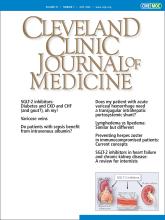Article Figures & Data
Tables
Trial Patients Intervention Primary composite end point Primary composite results Heart failure with reduced ejection fraction DAPA-HF (2019)8 4,744 adults
EF ≤ 40%
Established HF
eGFR < 30 mL/minute/1.73 m2Dapagliflozin 10 mg Cardiovascular death or worsening heart failure 16.3% vs 21.2%
(NNT = 21)EMPEROR-Reduced (2020)9 3,730 adults
EF ≤ 40%
Established HF
eGFR < 20 mL/minute/1.73 m2Empagliflozin 10 mg Cardiovascular death or worsening heart failure 19.4% vs 24.7%
(NNT = 19)Heart failure with preserved ejection fraction EMPEROR-Preserved (2021)15 5,988 adults
EF > 40%
New York Heart Association class II–IV HF
eGFR < 20 mL/minute/1.73 m2Empagliflozin 10 mg Cardiovascular death or hospitalization for heart failure 13.8% vs 17.1%
(NNT = 31)DELIVER-HF (2022)16 6,263 adults
EF > 40%
Stabilized HF
eGFR > 25 mL/minute/1.73 m2
With or without diabetes mellitusDapagliflozin 10 mg Cardiovascular death or worsening heart failure 16.4% vs 19.5%
(NNT = 32)Acute decompensated heart failure EMPULSE (2022)19 530 adults
Any EF
Acute decompensated HF
eGFR < 20 mL/minute/1.73 m2Empagliflozin 10 mg All-cause death, heart failure events,a Kansas
City Cardiomyopathy
Questionnaire score53.4% vs 39.7%
Win ratiob 1.36
(95% confidence interval: 1.09–1.68)SOLOIST-WHF (2021)20 1,222 adults
Any EF
Acute decompensated HF
eGFR < 30 mL/minute/1.73 m2
Type 2 diabetesSotagliflozin 200 or 400 mg Events of cardiovascular deaths, hospitalizations and urgent visits for heart failure 51% vs 76.3%
(NNT = 4)↵a EMPULSE: heart failure events include heart failure hospitalizations, urgent heart failure visit, unplanned outpatient heart failure visit, and worsening symptoms or intensification of therapy.
↵b Win ratio in favor of empagliflozin; the primary outcome analysis defined a “win” as when, in the common follow-up time, the patient did not die, have an increased number of exacerbations, have an earlier time to first exacerbation, or have a change in Kansas City Cardiomyopathy Questionnaire score < 5 points in hierarchal fashion. If any end point was achieved, it was considered a loss. The “wins ratio” was calculated for each group as the ratio of “wins” to “losses.”
DAPA-HF = Dapagliflozin and Prevention of Adverse Outcomes in Heart Failure; DELIVER-HF = Dapagliflozin Evaluation to Improve the Lives of Patients with Preserved Ejection Fraction Heart Failure; EF = ejection fraction; eGFR = estimated glomerular filtration rate; EMPEROR-Preserved = Empagliflozin Outcome Trial in Patients with Chronic Heart Failure with Preserved Ejection Fraction; EMPEROR-Reduced = Empagliflozin Outcome Trial in Patients with Chronic Heart Failure and a Reduced Ejection Fraction; EMPULSE = Empagliflozin in Patients Hospitalized With Acute Heart Failure Who Have Been Stabilized; HF = heart failure; NNT = number needed to treat; SOLOIST-WHF = Effect of Sotagliflozin on Cardiovascular Events in Patients With Type 2 Diabetes Post Worsening Heart Failure
Trial Patients Intervention Primary composite end point Primary composite results CREDENCE (2019)24 4,401 adults
eGFR 30–89 mL/minute/1.73 m2 and UACR 301–5,000 mg/g
Type 2 diabetesCanagliflozin 100 mg End-stage kidney disease,a double serum creatinine, or cardiovascular or renal death 43.2 vs 61.2 events/1,000 patient years
(NNT = 22)DAPA-CKD (2020)22 4,304 adults
eGFR 25–75 mL/minute/1.73 m2 and UACR 200–5,000 mg/g
With or without diabetes mellitusDapagliflozin 10 mg ≥ 50% sustained decline in eGFR, end-stage kidney disease,b or cardiovascular or renal death 9.2% vs 14.5%
(NNT = 19)EMPA-KIDNEY (2023)23 6,609 adults
eGFR 20–44 mL/minute/1.73 m2 or
eGFR 45–89 mL/minute/1.73 m2 and UACR ≥ 200 mg/g
With or without diabetes mellitusEmpagliflozin 10 mg Kidney disease progressionc or cardiovascular death 13.1% vs 16.9%
(NNT = 26)↵a CREDENCE: dialysis for at least 30 days, kidney transplantation, or eGFR < 15 mL/minute/1.73 m2.
↵b DAPA-CKD: maintenance dialysis ≥ 28 days, kidney transplantation, or eGFR < 15 mL/minute/1.73 m2.
↵c EMPA-KIDNEY: initiation of maintenance dialysis, receipt of kidney transplant, eGFR < 10 mL/minute/1.73 m2, sustained decrease in eGFR ≥ 40%, or renal death.
CREDENCE = Canagliflozin and Renal Events in Diabetes with Established Nephropathy Clinical Evaluation; DAPA-CKD = Dapagliflozin and Prevention of Adverse Outcomes in Chronic Kidney Disease; eGFR = estimated glomerular filtration rate; EMPA-KIDNEY = Study of Heart and Kidney Protection with Empagliflozin; NNT = number needed to treat; UACR = urine albumin-to-creatinine ratio
- TABLE 3
Indications, doses, and estimated glomerular filtration rate thresholds for sodium-glucose cotransporter 2 inhibitors
Sodium-glucose cotransporter 2 inhibitor Canagliflozin Dapagliflozin Empagliflozin Indication Glycemic control in type 2 diabetes 100 or 300 mg 5 or 10 mg 10 or 25 mg Major adverse cardiovascular events risk in type 2 diabetes and cardiovascular disease 100 or 300 mg 10 mg CVE risk in heart failure 10 mg 10 mg Heart failure hospitalization in type 2 diabetes and cardiovascular disease or cardiovascular risk 10 mg 10 mg Chronic kidney disease progression or CVE risk in type 2 diabetes and diabetic kidney disease 100 or 300 mg Chronic kidney disease progression or CVE risk in chronic kidney disease 10 mg 10 mg Minimum estimated glomerular filtration rate (mL/minute/1.73 m2) For type 2 diabetes 30 45 30 For other indications 30a 25a 20 CVE = cardiovascular events (cardiovascular death, hospitalization for heart failure, urgent heart failure visits)
↵a May continue therapy.
Data from references 8–10,15,16,19–27.






